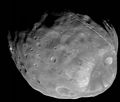Файл:Phobos colour 2008.jpg — Вікіпедія

Розмір при попередньому перегляді: 636 × 600 пікселів. Інші роздільності: 255 × 240 пікселів | 509 × 480 пікселів | 815 × 768 пікселів | 1086 × 1024 пікселів | 2172 × 2048 пікселів | 3500 × 3300 пікселів.
Повна роздільність (3500 × 3300 пікселів, розмір файлу: 2,72 МБ, MIME-тип: image/jpeg)
Історія файлу
Клацніть на дату/час, щоб переглянути, як тоді виглядав файл.
| Дата/час | Мініатюра | Розмір об'єкта | Користувач | Коментар | |
|---|---|---|---|---|---|
| поточний | 03:10, 2 квітня 2018 |  | 3500 × 3300 (2,72 МБ) | Kaldari | more margin on right side |
| 04:47, 13 листопада 2008 |  | 3374 × 3300 (2,7 МБ) | Fir0002 | == Summary == {{Information |Description=Colour image of Phobos, imaged by the Mars Reconnaisance Orbiter in 2008 |Source=NASA |Date=9 April 2008 |Location=http://www.nasa.gov/mission_pages/MRO/multimedia/pia10368.html |Author=NASA/J |
Використання файлу
Такі сторінки використовують цей файл:
Глобальне використання файлу
Цей файл використовують такі інші вікі:
- Використання в af.wikipedia.org
- Використання в an.wikipedia.org
- Використання в ar.wikipedia.org
- المريخ
- فوبوس
- قمرا المريخ
- ويكيبيديا:صور مختارة/الفضاء والكون/نظرة إلى الأعلى
- قائمة أجرام المجموعة الشمسية مرتبة حسب الحجم
- بوابة:علم الفلك/صورة مختارة
- بوابة:المريخ
- بوابة:المريخ/مقالة مختارة/أرشيف
- بوابة:المريخ/مقالة مختارة/2
- قائمة الأقمار الطبيعية
- خط زمني لاكتشاف كواكب المجموعة الشمسية وأقمارها
- ويكيبيديا:ترشيحات الصور المختارة/القمر فوبوس
- ويكيبيديا:صورة اليوم المختارة/أغسطس 2019
- قالب:صورة اليوم المختارة/2019-08-03
- بوابة:علم الفلك/صورة مختارة/73
- معسكر قاعدة المريخ
- ويكيبيديا:صورة اليوم المختارة/يناير 2022
- قالب:صورة اليوم المختارة/2022-01-04
- Використання в ary.wikipedia.org
- Використання в arz.wikipedia.org
- Використання в as.wikipedia.org
- Використання в azb.wikipedia.org
- Використання в az.wikipedia.org
- Використання в be-tarask.wikipedia.org
- Використання в be.wikipedia.org
- Використання в bg.wikipedia.org
- Використання в bh.wikipedia.org
- Використання в bn.wikipedia.org
- Використання в bn.wikibooks.org
- Використання в bs.wikipedia.org
Переглянути сторінку глобального використання цього файлу.


 French
French Deutsch
Deutsch



